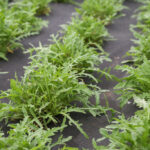The diseases and pests of broccoli

Maintaining the health of a broccoli crop requires a vigilant and proactive approach to managing the various diseases and pests that are attracted to this popular vegetable. As a member of the brassica family, broccoli is a target for a specific suite of adversaries that can cause significant damage, ranging from cosmetic blemishes to complete crop failure if left unchecked. A successful management strategy does not rely on a single solution but rather integrates multiple preventative and control measures. This includes cultural practices like crop rotation and proper spacing, regular monitoring to catch problems early, and the judicious use of organic or chemical controls when necessary.
The foundation of a disease and pest management program begins with creating a garden environment that is inherently less hospitable to these problems. Healthy, vigorous plants growing in nutrient-rich soil are naturally more resilient and better able to withstand pressure from pests and pathogens. Practices such as ensuring good air circulation through proper plant spacing, avoiding overhead watering that keeps leaves wet for extended periods, and rotating crops to different locations in the garden each year are fundamental preventative measures that disrupt the life cycles of many common diseases and pests, reducing their ability to become established.
Regular and thorough inspection of your broccoli plants is the next critical line of defense. Pests and the initial symptoms of disease are often easy to miss if you are not looking for them specifically. You should make it a routine to examine your plants at least a few times per week, paying special attention to the undersides of leaves, the growing points, and the base of the plant. Early detection allows for prompt intervention, which is often simpler and more effective than trying to control a widespread infestation or a well-established disease.
When intervention is required, a range of options is available, from simple mechanical removal to the application of biological or chemical treatments. The principle of Integrated Pest Management (IPM) advocates for using the least toxic methods first, such as hand-picking caterpillars or using a strong spray of water to dislodge aphids. For more persistent problems, biological controls like Bacillus thuringiensis (Bt) for caterpillars or insecticidal soaps for soft-bodied insects offer effective, targeted solutions. This multi-faceted approach minimizes environmental impact while maximizing the health and productivity of your broccoli crop.
Common fungal diseases
Fungal diseases represent a significant threat to broccoli, particularly in environments with high humidity and poor air circulation. One of the most prevalent of these is downy mildew, caused by the fungus-like organism Peronospora parasitica. The first signs of infection are typically pale green or yellow spots on the upper surfaces of the older leaves. As the disease progresses, a white to purplish, downy or fuzzy mold develops on the undersides of these spots. In severe cases, the affected leaves will wither and die, which can stunt the plant’s growth and reduce the size and quality of the head.
More articles on this topic
Another fungal issue to be aware of is Alternaria leaf spot, which is caused by fungi from the Alternaria genus. This disease manifests as small, dark spots on the leaves that enlarge into circular lesions with a characteristic “target spot” appearance, featuring concentric rings. The spots can eventually merge, causing large areas of the leaf to die. Under moist conditions, the disease can also infect the broccoli head itself, causing a brown or black rot that makes it inedible. The spores are spread by wind and splashing water, making it particularly problematic during rainy seasons.
White mold, also known as Sclerotinia stem rot, is a destructive disease that can affect the stems, leaves, and heads of broccoli plants. The infection usually begins near the soil line, causing water-soaked lesions that quickly become covered in a fluffy, white cotton-like mold. The stem may become soft and rotten, leading to the wilting and eventual collapse of the entire plant. As the disease progresses, hard, black structures called sclerotia, which resemble mouse droppings, may form within the moldy tissue. These sclerotia can survive in the soil for several years, making crop rotation an essential management tool.
Preventing these fungal diseases is always more effective than attempting to cure them. The key preventative strategies include ensuring generous spacing between plants to promote good air circulation, which helps leaves dry quickly. Utilizing drip irrigation or soaker hoses to water the soil directly while keeping the foliage dry is also critically important. At the end of the season, it is vital to remove and destroy all crop debris, as many fungal pathogens can overwinter on dead plant material and re-infect the garden the following spring.
Bacterial infections to watch for
Bacterial diseases can be just as devastating to a broccoli crop as fungal infections, and they often spread rapidly in warm, wet weather. One of the most serious bacterial diseases is black rot, caused by Xanthomonas campestris. The most distinctive symptom of this disease is the appearance of large, V-shaped yellow lesions that form along the margins of the leaves, with the point of the “V” typically directed towards a vein. The veins within these lesions turn black, and the infected tissue eventually dries out and becomes brown and brittle, severely reducing the plant’s photosynthetic capacity.
More articles on this topic
Bacterial soft rot, caused by various species of bacteria like Pectobacterium and Dickeya, is another destructive disease that can quickly turn a promising broccoli head into a foul-smelling, mushy mess. The bacteria typically enter the plant through wounds caused by insects, hail, or mechanical damage. Once inside, they break down the plant tissues, starting with small, water-soaked spots on the head or stem that rapidly expand. The infected area becomes soft and slimy and often emits a strong, unpleasant odor, rendering the entire head completely inedible.
Managing bacterial diseases relies heavily on sanitation and prevention, as there are very few effective chemical treatments available to home gardeners once an infection has taken hold. A primary strategy is to always start with certified disease-free seed from a reputable source, as some bacteria, like the one causing black rot, can be transmitted on the seed itself. Additionally, you should avoid working in the garden when the plants are wet, as this can easily spread bacteria from one plant to another on your hands, tools, or clothing.
Practicing strict crop rotation is also a crucial defense against the buildup of bacterial pathogens in the soil. Do not plant broccoli or any of its close relatives (cabbage, cauliflower, kale, etc.) in the same location more than once every three to four years. Furthermore, ensure your garden has good drainage, as waterlogged soil can stress the plants and create conditions favorable for root-infecting bacteria. Promptly removing and destroying any plants that show symptoms of a bacterial infection can help to prevent the disease from spreading to the rest of your crop.
Managing cabbage worms and loopers
Among the most common and voracious pests of broccoli are the larvae of several different butterfly and moth species, collectively known as cabbage worms. The most frequent culprits are the imported cabbageworm, which is the velvety green larva of the white cabbage butterfly, and the cabbage looper, a smooth-skinned, light green caterpillar that moves with a distinctive “looping” or inchworm-like motion. Both of these pests chew ragged holes in the leaves of broccoli plants and can also burrow into the developing heads, contaminating them with their bodies and frass (excrement).
Regular and careful inspection is the first step in managing these caterpillars. The adult butterflies and moths are active during the day, and you can often see them flitting around your brassica plants, laying their small, yellowish, bullet-shaped eggs singly on the undersides of the leaves. By checking the leaves every few days and simply rubbing off these eggs, you can prevent a major infestation before it even begins. If you find the caterpillars themselves, hand-picking them off the plants and dropping them into a bucket of soapy water is a very effective, albeit labor-intensive, control method for a small garden.
For a more hands-off preventative approach, the use of floating row covers is highly recommended. These lightweight fabric covers can be draped over the plants at the time of transplanting and secured at the edges to create a physical barrier. This barrier prevents the adult butterflies and moths from ever reaching the plants to lay their eggs. The covers are permeable to light, air, and water, so they do not hinder plant growth. They are one of the most effective organic methods for preventing damage from these and other flying pests.
If an infestation becomes too large to manage by hand-picking, a biological insecticide containing Bacillus thuringiensis var. kurstaki (Btk) is an excellent and safe option. Btk is a naturally occurring bacterium that is toxic only to the larval stage of moths and butterflies. When a caterpillar ingests the Btk spray on a leaf, it stops feeding within hours and dies within a couple of days. This product is highly specific, so it will not harm bees, beneficial insects, pets, or humans, making it an ideal choice for an environmentally conscious pest management program.
Controlling aphids and flea beetles
Aphids are small, soft-bodied, pear-shaped insects that can become a major nuisance on broccoli plants, often congregating in large colonies on the undersides of leaves and on tender new growth. They feed by piercing the plant tissues and sucking out the nutrient-rich sap, which can cause the leaves to curl, yellow, and become distorted. As they feed, aphids excrete a sticky substance called honeydew, which can lead to the growth of sooty mold and can also attract ants. While small populations may not cause significant harm, large infestations can weaken the plant and reduce yields.
One of the simplest and often most effective methods for controlling a minor aphid infestation is to use a strong jet of water from a garden hose. This physically dislodges the aphids from the plant, and many will be unable to return. This process can be repeated every few days as needed. For more persistent populations, an application of insecticidal soap can be very effective. These soaps work by disrupting the outer cell membranes of the insects, and they are most effective when sprayed directly onto the aphids, ensuring thorough coverage of the colonies.
Flea beetles are another common pest of broccoli, particularly damaging to young seedlings. These small, dark beetles get their name from their ability to jump like fleas when disturbed. They chew numerous small, round “shot holes” in the leaves of the plants. While mature broccoli plants can typically tolerate this damage, a heavy infestation on young transplants can severely stunt their growth or even kill them. Protecting young plants with a floating row cover immediately after transplanting is the most reliable way to prevent flea beetle damage.
Encouraging natural predators in your garden is a key component of a long-term, sustainable strategy for managing both aphids and flea beetles. Ladybugs, lacewings, and hoverflies are all voracious predators of aphids, and their presence can keep populations in check. You can attract these beneficial insects by planting a diversity of flowering plants, such as dill, cilantro, and sweet alyssum, near your vegetable patch. This integrated approach creates a more balanced ecosystem in your garden where pest populations are less likely to get out of control.
Integrated pest management principles
Integrated Pest Management, or IPM, is a holistic and science-based approach to managing pests and diseases that prioritizes long-term prevention and uses a combination of different control tactics. Rather than seeking to eradicate pests entirely, the goal of IPM is to keep their populations below a level where they cause economically or aesthetically significant damage. This approach minimizes risks to human health and the environment by reducing the reliance on broad-spectrum chemical pesticides and instead focusing on understanding the life cycles of pests and their interaction with the environment.
The foundation of any IPM program is prevention. This involves selecting plant varieties that are well-suited to your climate and may have some natural resistance to common pests and diseases. The core of prevention, however, lies in cultural practices that create a healthy garden ecosystem. This includes building fertile soil with plenty of organic matter, practicing crop rotation, using proper sanitation by cleaning up crop debris, and ensuring optimal plant spacing to promote air circulation. A healthy, stress-free plant is the first and best line of defense against most problems.
Regular monitoring and correct pest identification are the next crucial steps in the IPM process. You cannot effectively manage a problem if you do not know what it is. This involves frequent scouting of your broccoli patch to look for the first signs of trouble, whether it be insect damage, eggs on the undersides of leaves, or the early symptoms of a disease. Once a potential pest is found, it is important to identify it correctly to understand its life cycle and vulnerabilities. This knowledge allows you to choose the most effective and targeted control method.
When control actions are needed, IPM dictates that you should start with the methods that have the lowest risk and impact. This could mean using physical or mechanical controls like hand-picking pests, setting traps, or using row covers as barriers. If further action is required, the next step would be to use biological controls, such as encouraging natural predators or applying specific microbial pesticides like Btk. Only as a last resort, when other methods have failed and the pest population has reached a predetermined action threshold, would the use of targeted, low-toxicity chemical pesticides be considered.



















